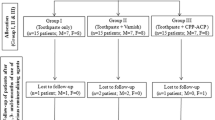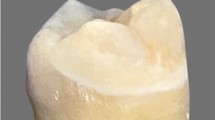Abstract
Objectives
To assess the remineralization capacity of carious, non-carious, and combined white spot lesions (WSLs) using the ICDAS and SS-OCT.
Materials and methods
This clinical trial was based on a quasi-experimental design. Forty-two healthy subjects (median age 26.6 years), who visited university hospital and had at least one WSL with an ICDAS score of 2 or 1, were recruited. The subjects chewed a non-blind sugar-free gum containing bioavailable calcium and fluoride for 3 months. The remineralization capacities of carious and non-carious 121 WSLs were assessed using ICDAS by two calibrated non-blind examiners and optical boundary depth (BD) by SS-OCT at a monthly recall. The outcome variables, transitions of ICDAS score, mean BD, and mean BD recovery rate (RR%), were statistically analyzed using the chi-square test, two way-repeated measures ANOVA, and Wilcoxon rank sum test, respectively (alpha = 0.05).
Results
Based on the visual inspection, OCT images at the baseline, 72 WSLs were purely carious, 20 were non-carious (developmental) lesions, while 29 were combined (carious-developmental). The responses of WSLs over time showed to be highly variable. There was a significant difference in transitions of ICDAS scores after 3 months between carious and non-carious WSLs (p < 0.05) and non-carious and combined WSLs (p < 0.05). Carious and combined WSLs underwent significant changes in the mean BD between baseline (161.8 ± 56.8 μm) and 2 months (130.7 ± 57.4 μm) or 3 months (119.1 ± 57.5 μm) (p < 0.05), while there was no significant difference between baseline (132.2 ± 26.2 μm) and 2 months (122.8 ± 24.1 μm) or 3 months (119.8 ± 22.6 μm) in non-carious WSLs (p > 0.05). There was a significant difference in mean RR% after 2 and 3 months between carious and non-carious WSLs (p < 0.05).
Conclusions
The remineralization capacity of WSL was variable among the cases and subjects, and depended on the WSLs history, etiology (carious, non-carious, or combined lesion) and structure (histological pattern).
Clinical relevance
Carious WSLs showed the highest remineralization potential.





Similar content being viewed by others
References
Featherstone JD (2008) Dental caries: a dynamic disease process. Aust Dent J 53:286–291
Cochrane NJ, Shen P, Byrne SJ, Walker GD, Adams GG, Yuan Y, Reynolds C, Hoffmann B, Dashper SG, Reynolds EC (2012) Remineralisation by chewing sugar-free gums in a randomised, controlled in situ trial including dietary intake and gauze to promote plaque formation. Caries Res 46:147–155
Kitasako Y, Tanaka M, Sadr A, Hamba H, Ikeda M, Tagami J (2011) Effects of a chewing gum containing phosphoryl oligosaccharides of calcium (POs-Ca) and fluoride on remineralization and crystallization of enamel subsurface lesions in situ. J Dent 39:771–779
Kitasako Y, Sadr A, Hamba H, Ikeda M, Tagami J (2012) Gum containing calcium-fluoride reinforces enamel subsurface lesion in situ. J Dent Res 91:370–375
Sugiura M, Kitasako Y, Sadr A, Shimada Y, Sumi S, Tagami J (2016) White spot lesion remineralization by sugar-free chewing gun containing bio-available calcium and fluoride: a double-blind randomized controlled trial. J Dent 54:86–91
Featherstone JD (2012) Remineralization, the natural caries repair process-the need for new approaches. Adv Dent Res 21:4–7
Guzmán-Armstrog S, Chalmers J, Warren JJ (2010) Ask us. White spot lesions: prevention and treatment. Am J Orthod Dentofac Orthop 138:690–696
Suckling GW (1989) Developmental defects of enamel: historical and present-day perspectives of their pathogenesis. Adv Dent Res 3:87–94
Seow WK (1997) Clinical diagnosis of enamel defects: pitfalls and practical guidelines. Int Dent J 47:173–182
Ismail AI, Sohn W, Tellez M, Amaya A, Sen A, Hasson H, Pitts NB (2007) The International Caries Detection and Assessment System (ICDAS): an integrated system for measuring dental caries. Community Dent Oral Epidemiol 35:170–178
Gomez J (2015) Detection and diagnosis of the early caries lesion. BMC Oral Health 15(suppl 1):S3
Meller C, Santamaria RM, Connert T, Splieth C (2012) Predicting caries by measuring its activity using quantitative light-induced fluorescence in vivo: a 2-year caries increment analysis. Caries Res 46:361–367
Huang D, Swanson EA, Lin CP, Schuman JS, Stinson WG, Chang W, Hee MR, Flotte T, Gregory K, Puliafito CA (1991) Optical coherence tomography. Science 254:1178–1181
Yamauchi M (2009) Visualization of phase retardation of deep posterior eye by polarization-sensitive swept-source optical coherence tomography with 1-microm probe. Opt Express 17:12385–12396
Choma M (2003) Sensitivity advantage of swept source and fourier domain optical coherence tomography. Opt Express 11:2183–2189
Sadr A, Mandurah M, Nakashima S, Shimada Y, Kitasako Y, Tagami J (2013) Monitoring of enamel lesion remineralization by optical coherence tomography: an alternative approach towards signal analysis. Proc SPIE 8566:856602
Ibusuki T, Kitasako Y, Sadr A, Shimada Y, Sumi Y, Tagami J (2015) Observation of white spot lesions using swept source optical coherence tomography (SS-OCT): in vitro and in vivo study. Dent Mater J 34:545–552
Ferreira Zandona A, Santiago E, Eckert G, Fontana M, Ando M, Zero DT (2010) Use of ICDAS combined with quantitative light-induced fluorescence as a caries detection method. Caries Res 44:317–322
Shimada Y, Sadr A, Burrow MF, Tagami J, Ozawa N, Sumi Y (2010) Validation of swept-source optical coherence tomography (SS-OCT) for the diagnosis of occlusal caries. J Dent 38:655–665
Espigares J, Sadr A, Hamba H, Shimada Y, Otsuki M, Tagami J, Sumi Y (2015) Assessment of natural enamel lesions with optical coherence tomography in comparison with microfocus X-ray computed tomography. J Med Imaging (Bellingham) 2:014001
Kho HS, Lee SW, Chung SC, Kim YK (1999) Oral manifestations and salivary flow rate, pH and buffer capacity in patients with end-stage renal disease undergoing hemodialysis. Oral Surg Oral Med Oral Pathol Oral Radiol Endod 88:316–319
Kitasako Y, Moritsuka M, Foxton RM, Ikeda M, Tagami J, Nomura S (2005) Simplified and quantitative saliva buffer capacity test using a hand-held pH meter. Am J Dent 18:147–150
ten Cate JM, Featherstone JD (1991) Mechanistic aspects of the interactions between fluoride and dental enamel. Crit Rev Oral Biol Med 2:283–296
Fried D, Xie J, Shafi S, Featherstone JD, Breunig TM, Le C (2002) Imaging caries lesions and lesion progression with polarization sensitive optical coherence tomography. J Biomed Opt 7:618–627
Lee RC, Staninec MS, Le O, Fried D (2016) Infrared methods for assessment of the activity of natural enamel caries lesions. IEEE J Sel Top Quantum Electron 22:102–110
Kitasako Y, Cochrane NJ, Khairul M, Shida K, Adams GG, Burrow MF, Reynolds EC, Tagami J (2010) The clinical application of surface pH measuements to longitudinally assess white spot enamel lesions. J Dent 38:584–590
Hay DI, Carlson ER, Schluckbier SK, Moreno EC, Schlesinger DH (1987) Inhibition of calcium phosphate precipitation by human salivary acidic proline-rich proteins: structure-activity relationships. Calcif Tissue Int 40:126–132
Acknowledgements
The authors would like to thank all individual participants who took part in this study.
Funding
This study was funded by a Grant-in Aid for Scientific Research (grant number 16K11541) from the Japan Society for the Promotion of Science (JSPS).
Author information
Authors and Affiliations
Corresponding author
Ethics declarations
Conflict of interest
The authors declare that they have no conflicts of interest.
Ethical approval
All procedures performed in studies involving human participants were in accordance with the ethical standards of the institutional and/or national research committee and with the 1964 Helsinki Declaration and its later amendments or comparable ethical standards.
Informed consent
Informed consent was obtained from all individual participants included in the study.
Rights and permissions
About this article
Cite this article
Kitasako, Y., Sadr, A., Shimada, Y. et al. Remineralization capacity of carious and non-carious white spot lesions: clinical evaluation using ICDAS and SS-OCT. Clin Oral Invest 23, 863–872 (2019). https://doi.org/10.1007/s00784-018-2503-1
Received:
Accepted:
Published:
Issue Date:
DOI: https://doi.org/10.1007/s00784-018-2503-1




